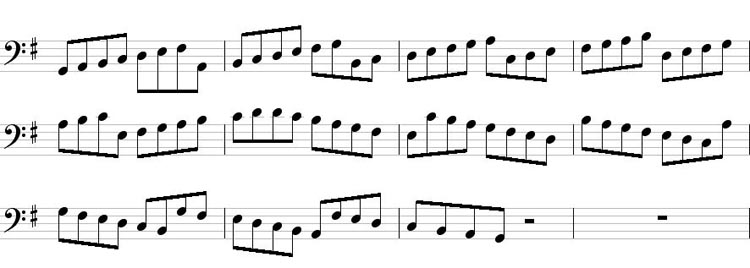SEQUENCING
EXERCISES
This month I’ll introduce you to yet another approach for making
our scale patterns sound more musical. This will be the last lesson
in this particular series of technical exercises, and next time around
we will get into some specific applications.
A sequence is simply a series of scale fragments based on a predetermined
number of notes. With sequencing exercises, a new scale fragment begins
on each successive note in the scale. Sequences apply nicely to just
about any musical structure on the bass, and when mixed with intervals
and other musical components, they make for some really interesting
sounds.
For example, if we wanted to apply sequenced 3’s to a C major scale
in a single octave, it would sound like this (see Ex. 1):
Ex. 1

Playing sequenced 3’s means you play 3 successive scale degrees
from each individual note of the scale. Written on a staff in scale
degrees, it would look like this (See Fig. 1):
Fig. 1

Top
These types of exercises are great candidates for use with the modal
fingerings of the major scale. For purposes of demonstration, we will
use a 3 note per string version of the G major scale played on a 4 string
bass for these exercises, playing through the entire range of the fingering
(See Fig. 2) The first note of the fingering would be played
on the 3rd fret, E string:
Fig. 2

Just as with the intervallic exercises we’ve worked on before,
I like to practice sequences going from 2’s through 7’s. Remember:
You want to keep your hand in the same fingering position shown in Fig.
2 as you play through each example. We are trying to cover all of the
notes without shifting out of position. Here are each of the exercises
for G major played both ascending and descending. The order of scale
degrees is shown after each example.
Ex. 2: Sequenced 2’s

scale
degrees:
ascending: 1-2-2-3-3-4-4-5-5-6-6-7-7-8-8-9-9-10-10-11-11-12
descending: 12-11-11-10-10-9-9-8-8-7-7-6-6-5-5-4-4-3-3-2-2-1
Top
Ex.
3: Sequenced 3’s

scale degrees:
ascending: 1-2-3-2-3-4-3-4-5-4-5-6-5-6-7-6-7-8-7-8-9-8-9-10-9-10-11-10-11-12
descending: 12-11-10-11-10-9-10-9-8-9-8-7-8-7-6-7-6-5-6-5-4-5-4-3-4-3-2-3-2-1
Ex.
4: Sequenced 4’s

scale degrees:
ascending: 1-2-3-4-2-3-4-5-3-4-5-6-4-5-6-7-5-6-7-8-6-7-8-9-7-8-9-10-8-9-10-11-9-10-11-12
descending: 12-11-10-9-11-10-9-8-10-9-8-7-9-8-7-6-8-7-6-5-7-6-5-4-6-5-4-3-5-4-3-2-4-3-2-1
Top
Ex.
5: Sequenced 5’s

scale degrees:
ascending: 1-2-3-4-5-2-3-4-5-6-3-4-5-6-7-4-5-6-7-8-5-6-7-8-9-6-7-8-9-10-7-8-9-10-11-8-9-10-11-12
descending: 12-11-10-9-8-11-10-9-8-7-10-9-8-7-6-9-8-7-6-5-8-7-6-5-4-7-6-5-4-3-6-5-4-3-2-5-4-3-2-1
Ex.
6: Sequenced 6’s

scale degrees:
ascending: 1-2-3-4-5-6-2-3-4-5-6-7-3-4-5-6-7-8-4-5-6-7-8-9-5-6-7-8-9-10-6-7-8-9-10-11-7-8-9-10-11-12
descending: 12-11-10-9-8-7-11-10-9-8-7-6-10-9-8-7-6-5-9-8-7-6-5-4-8-7-6-5-4-3-7-6-5-4-3-2-6-5-4-3-2-1
Top
Ex.
7: Sequenced 7’s

scale degrees:
ascending: 1-2-3-4-5-6-7-2-3-4-5-6-7-8-3-4-5-6-7-8-9-4-5-6-7-8-9-10-5-6-7-8-9-10-11-6-7-8-9-10-11-12
descending: 12-11-10-9-8-7-6-11-10-9-8-7-6-5-10-9-8-7-6-5-4-9-8-7-6-5-4-3-8-7-6-5-4-3-2-7-6-5-4-3-2-1
As
you can see, these open up many more possibilities for creating hybrid
approaches that mix sequences with intervals. You could combine a selected
sequence with an intervallic exercise to create some really unique sounding
lines. Don’t forget to work on these with some sort of external
clock source, like a metronome or drum machine. As always, you are striving
for accuracy and cleanliness in your phrasing. Work these up through
all of your modal patterns and scales. Next time we’ll dive into
some more unique applications.
Top